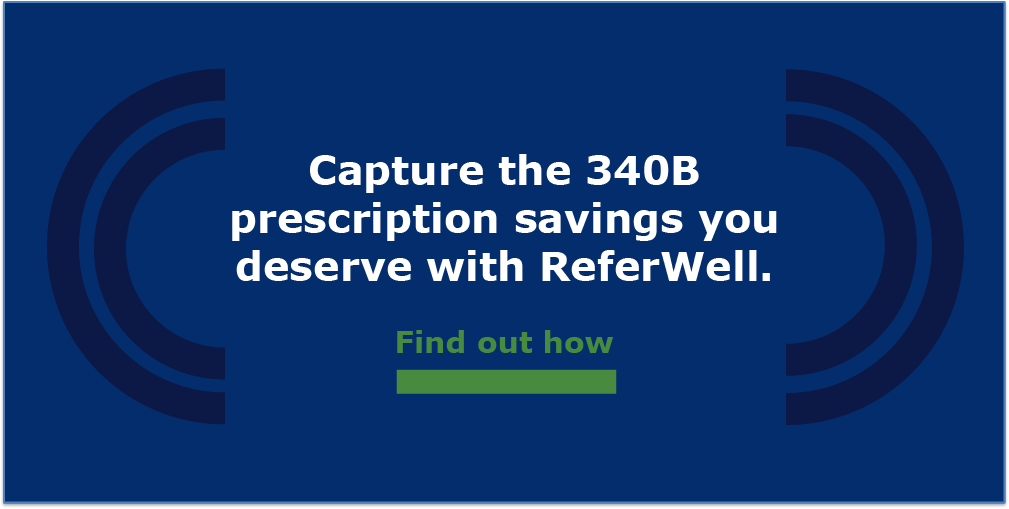What Pharma Attacks on 340B Mean for FQHCs and CHCs

By now, you’ve probably read at least a few articles on how the pharmaceutical industry is trying to withhold 340B drug savings from certain health care organizations. If you’re employed by a Federally Qualified Health Center (FQHC) or Community Health Center (CHC), you may have even heard your finance team express concern about adding any revenue-generating 340B solutions to capture referrals and improve program compliance.
After my many years working with FQHCs on 340B referral capture, I’m sharing this post to encourage you to take a calming breath of fresh air. (Just make sure it’s a socially distanced breath.)
FQHCs and CHCs are undoubtedly feeling the pressure from large pharmaceutical companies to alter the 340B reimbursement landscape. It’s even more important now than ever to rein in your 340B program compliance and maximize savings — both of which are possible even with the potential updates to the 340B Program.
Why is Pharma Fighting 340B?
This year, Pharma is facing additional threats to their profits following the Trump administration’s push for transparency and pricing caps.
Think of Pharma as the playground bully, saying, “Oh yeah? You’re going to take money from me on prescription drugs? Well then I’m going to stop giving as many drug discounts.”
Pharma's Real Issue is with Disproportionate Share Hospitals, not FQHCs and CHCs
Approximately two-thirds of the 340B Drug Pricing Program benefits go to Disproportionate Share Hospitals (DSH). These are hospitals that “serve a significantly disproportionate number of low-income patients and receive payments from the Centers for Medicaid and Medicare Services to cover the costs of providing care to uninsured patients,” according to the Health Resources and Services Administration (HRSA), the government entity in charge of the 340B Program.
There has always been a tug of war regarding the DSH ratio and the hospitals eligible for 340B savings. Right now, HRSA defines the “significant number of low-income patients” as 11.75% of patients under the poverty line. Consider that some of the biggest names in the DSH category are in major US cities, where the cost of living is much higher and more people are therefore considered to be living in poverty. (If you’re a numbers person looking for more information on how the Census Bureau defines living in poverty, you can find that here.)
Pharma is looking to bump up that percentage to 15 or 16% of patients living in poverty for DSH eligibility. Fewer people in poverty = fewer DSHs = more money for pharma.
Pharma is always looking at ways to eliminate the low-cost 340B prescriptions without alienating its provider and patient base. This latest tactic is a great example. Pharma has approached FQHCs and tried to pressure them into signing plans that would give them lower discounts or risk not getting reimbursements at all. FQHCs are joining forces to fight back, though, and Washington lobbyists continue to fight on both sides of the issue.
No changes are expected before November 4. With two presidential candidates with such differing opinions on universal health care, the winner will have a big impact on what happens with 340B. Even then, it is almost certain that the 340B Program will continue, though hospitals will likely participate differently.
What can FQHCs and CHCs do now?
First, don’t panic.
States are not about to let FQHCs go out of business. These health centers provide vital care to underserved populations that otherwise might go without care, getting sicker and costing states more. States that are major Medicaid providers are not about to let that happen and Pharma knows that.
Second, do keep improving.
Don’t hesitate to add a solution to improve 340B compliance, especially when implementation is simple and the only cost is a percentage of your additional profits.
When you work with a vendor that thinks holistically about care coordination, rather than focusing exclusively on 340B, you’ll see benefits across your organization. By creating a Virtually Integrated Network focused on more efficient transitions of care, you can:
- Schedule appointments (in-person or virtual) and improve show rate by at least 60%
- Improve access to care, by directing patients to the most appropriate specialists
- Close 35% more care gaps
- Send and receive notes across EMRs and double specialists’ loop closure rates
- Benefit from ReferWell Care Navigators’ operational support and
- Improve health outcomes for your entire patient population
Bottom line: Until HRSA tells your FQHC or CHC to sign a deal with Pharma, don’t. Always ask yourself, “What has HRSA advised you?”
https://www.census.gov/topics/income-poverty/poverty/guidance/poverty-measures.html
Written by Tom Mackintire
Tom is a trusted advisor helping Medicare Advantage, Medicaid and ACA plan executives meet their quality and member outcome goals. Tom has 20+ years of sales and leadership experience within the healthcare market. He is also an expert on the 340B Program and helps health centers maximize 340B savings through better referral management.

 © COPYRIGHT REFERWELL
© COPYRIGHT REFERWELL 